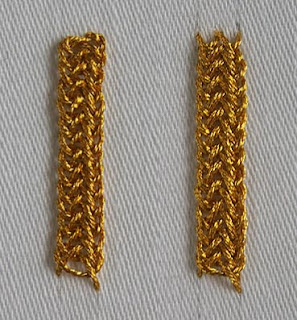Over the past few days, in response to a personal challenge from Mary Corbet of Needle’nThread.com I have been trying out plaited braid stitch.
It is notorious for being a Very Difficult Stitch. I’m wondering why… I didn’t find it all that hard.
I had some basic instructions in Mary Thomas’s Dictionary of Embroidery Stitches. They’re not great instructions, and looking at antique examples, I also suspect they are not quite right. So I adapted them, following others’ advice, and got a very pleasing result.
Then I found that I have a copy of Leon Conrad’s specially devised way of working Plaited Braid Stitch in an old edition of FineLines Magazine, so I got to work using them also. It is extremely interesting to note that while Leon’s instructions produce the same result, they are worked from the other end of the stitching. ie what Mary Thomas would consider to be the end, Leon makes his beginning. Really interesting!
Leon must have spent a LOT of time studying historical examples in museums and playing with a needle and thread to devise his method. I am all in awe. I guess this is akin to what I did when I was at the Ukrainian Museum in New York, trying to work out how the merezhka I was looking at had been done. I understand the amount of work that goes into this sort of sleuthing!
However, I feel that some of the photography in Leon’s instructions could have been a little better. Sometimes I’m not quite clear on what I am looking at. Never mind – I worked it out! I found Leon’s instructions easier to learn from and that they gave a better result.
 The adapted version of Mary’s is on the left, and Leon’s is on the right.
The adapted version of Mary’s is on the left, and Leon’s is on the right.
I will be including left-handed instructions for plaited braid stitch for my left-handed stitch dictionary.

 White Threads is the blog of Yvette Stanton, the author, designer, publisher behind Vetty Creations' quality needlework books and embroidery products.
White Threads is the blog of Yvette Stanton, the author, designer, publisher behind Vetty Creations' quality needlework books and embroidery products.

Those both look terrific! They look REALLY terrific.
You know what I find difficult about the stitch? Remembering which step is next. I don’t know why – it just won’t stick. I suppose that means I need to practice it a bit more?
You’ve inspired me to practice, practice, practice!
What thread are you using, by the way? Looks as if you’re working on twill, but I can’t tell what kind of thread it is….
Thanks, Yvette!
Hi Mary,
Thanks! Yes, I think practice is the key for remembering which step is next. Once you get the rhythm you’ll be fine. With Leon’s there are three steps. With Mary Thomas’s there are two. (Not counting the initial set-up bits at the beginning of both methods.)
You know, as soon as I’d posted, I thought “I should have said what thread I’m using.” And there you go – you do want to know!
I’m using Madeira Metallic No 3 Colour 3007. It is a synthetic multi-stranded cordish sort of thread. You have to make sure all the strands are out of the way of your needle, which is a bit of a pain. But I only have one proper jap thread, and it was too thin. I wanted to try it with something gold, and this was the best option amongst my stash. Its certainly very sparkly!
Worked on polycotton satin jean. Its what I work most of my Mountmellick on, so I have LOTS of scraps lying around.
Now if only I could think of something to use the stitch on…
There’s some plaited braid in the newest issue of Sampler and Antique Quarterly – there’s a spot sampler design by Sharon Cohen that uses it quite a bit. I like old fashioned samplers and this one rather calls to me (and it isn’t the plaited braid stitch holding me back, it’s the idea of another work in progress, really!!)
Thanks for that Cathymk, I’ll have to look out for it.
Very beautiful braids. I wonder which is the difference of execution between both of them? Because they look very simmilar but when you look it carefully there is a difference.
Hi Boudica,
The difference is that one is worked from the top, down, and the other is worked from the bottom up.